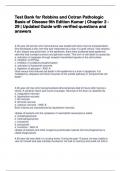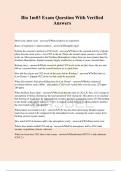Exam (elaborations)
Test Bank for Robbins and Cotran Pathologic Basis of Disease 9th Edition Kumar | Chapter 2 - 29 | Updated Guide with verified questions and answers
- Course
- Institution
Test Bank for Robbins and Cotran Pathologic Basis of Disease 9th Edition Kumar | Chapter 2 - 29 | Updated Guide with verified questions and answers
[Show more]




